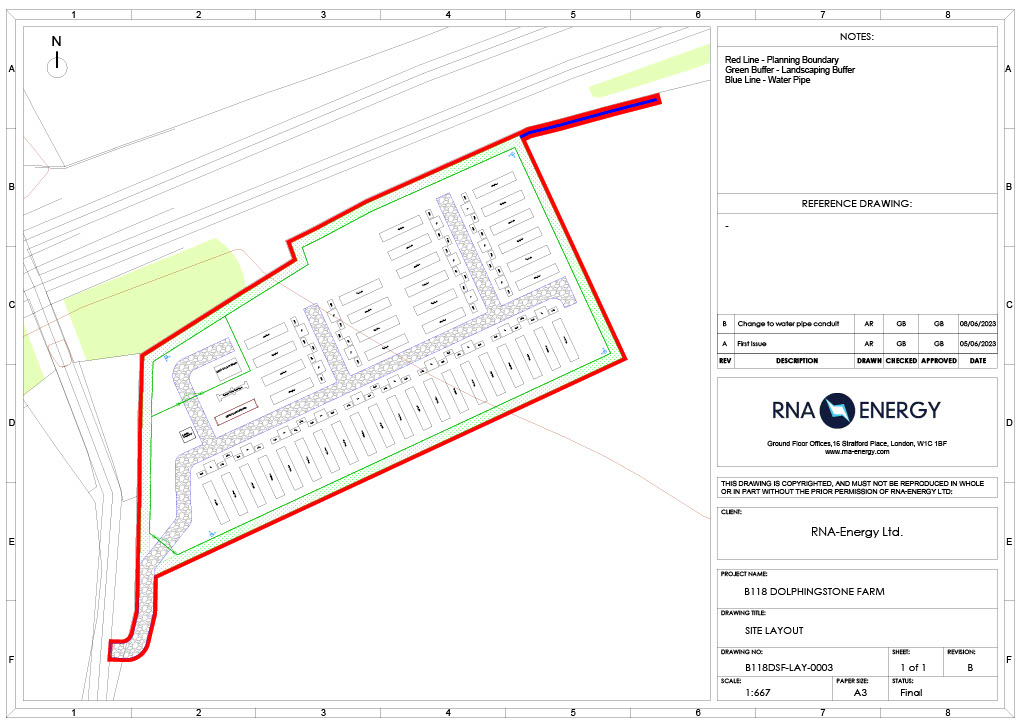RNA Energy is currently preparing a planning application for a Battery Energy Storage System (BESS) facility at Dolphingstone Farm, Tranent
RNA Energy is developing and building a portfolio of energy storage and solar facilities to power the UK with cheap, clean, and reliable energy.
The RNA Energy Team is highly experienced and passionate about building infrastructure that is needed for a net zero future.
RNA Energy is looking to deliver a number of BESS facilities in the UK. These facilities enable energy to be stored and delivered back to the grid when it is most needed. This helps when renewable facilities, like solar, are not operating at their peak.
As an experienced developer, we specialise in finding viable and cost-effective grid connection points and engaging with landowners to deliver sustainable infrastructure.
Why are Battery Energy Storage System (BESS) developments needed?
BESS is comprised of rechargeable batteries that covert electrochemical energy to electrical energy, and vice versa, as required.
The Scottish Government’s commitment to ‘Net Zero’ emissions by 2045 requires more sustainable energy production, such as solar and wind development, which combined with the closing old, large-scale coal and nuclear power stations, has put pressure on electricity distribution.
Renewable energy cannot always consistently produce electricty at all hours of the day. This is called intermittency. Using BESS smooths out the intermittency, taking the pressure off of the network’s essential equipment.
The installation of BESS developments supports Scotland’s transition from fossil fuels to greener, renewable and more reliable power generation.
Storing electricity locally allows for focused management of the network, benefitting local residents and businesses:
- Provision of locally produced power during times of stress reduces the risk of power outages to the immediate locality and results in savings in usage charges which may be reflected in customers‘ bills.
- Having a storage facility embedded in the local network means the area is less likely to experience power shortages and blackouts. These can be caused by the loss of inertia created by the increased input from renewable generation on the network.
- BESS facilities reduce demand on the national network as a whole, which in turn makes the local network less volatile.
- Storage and discharge of power near to the point of use reduces power line transmission losses that are experienced when power is generated centrally. This helps to reduce CO2 emissions.
RNA Energy is preparing a planning application for a BESS facility on land located off Johnnie Cope’s Road, Tranent EH21 8GL, to be known as Dolphingstone Farm BESS.
The Site has been identified following an extensive site selection process which considers environmental designations, local electricity network access and capacity, the physical characteristics of the site and the need for a supportive landowner.
The plans are still in the development stages, so our design proposals will evolve as local input is gathered and technical considerations are investigated further.
Once operational, Dolphingstone BESS would make a valuable contribution towards tackling the climate emergency in East Lothian, and wider area, by providing balancing services to maintain a cleaner, greener and cheaper energy supply.
The project will be capable of storing 63MW of electricity to supply to the national grid in times of need, providing enough back up energy for around 13,300 homes.
Access to the Site for construction would be via Johnnie Cope’s Road, from the south.
Our plans will also include landscape planting and improvements to biodiversity which will assist in screening the development and encouraging additional wildlife to the Site.

Here is a summary of what our plans include:
- 0.6 hectares (ha), with 40 lithium-ion battery containers;
- Client control room;
- District Network Operator (DNO) control room;
- Outdoor rated switchgear;
- Auxiliary transformer;
- Security fencing;
- CCTV;
- Landscape buffer.
Construction and Operation
Construction is anticipated to take 8-12 months and would involve the formation of a series of concrete plant bases, service trenches, an access road, fencing, CCTV and gates.
The only vehicles required to attend the Site when the facility is operational would be those associated with security and maintenance. This is anticipated to be no greater than 1 LGV per month.